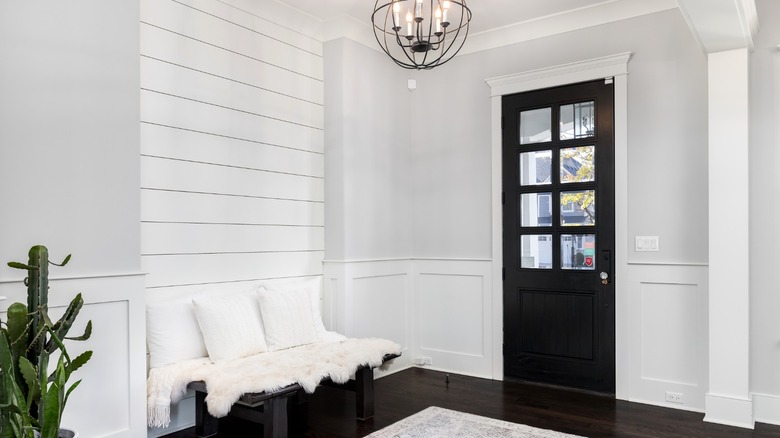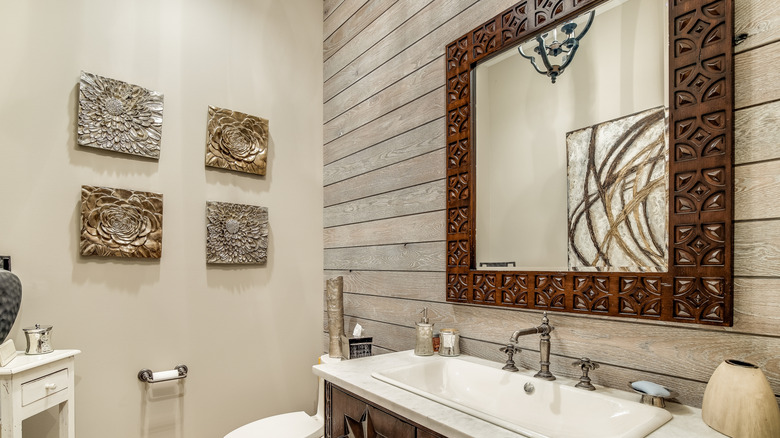Create A Fixer Upper-Inspired Accent Wall For Less With A Clever Dollar Tree Hack
Easy to install and offering an effortless dash of rustic yet sophisticated charm, shiplap is a "Fixer Upper" favorite for good reason. The flexible design can enhance almost any space, whether you want to steal Joanna Gaines' shiplap look in the kitchen, living room, or bedroom. Then, there's all the ways to create it. With the proper resources, know-how, and motivation, you can go all-out with a wood installation. Meanwhile, those looking for a budget- and DIY-friendly layout need to look no further than simple foam board. Head to Dollar Tree for some Readi-Board White Foams Boards at $1.25 a piece, and form them to the wooden planks' shape and texture to make the shiplap wall of your dreams!
The idea for this clever Dollar Tree hack is to cut the foam board into equal strips, mimicking the shiplap board dimensions. At 20 by 30 inches, the boards can be cut into three equal pieces roughly 6 ⅔ inches wide, which is about average for shiplap boards. Alternatively, you could go thicker with two 10-inch planks. With these, you can add a wood texture using different paint tricks. Of course, the rules are loose, so you could also try unique colors and textures for funkier farmhouse features. After styling your accent wall boards, install them with a brad nailer to promote an authentic look. You could also take it easy with adhesive putty or double-sided tape, such as EZlifego Double-Sided Tape, for a rental-friendly DIY that won't jeopardize your deposit.
Creating a shiplap effect with Dollar Tree foam board
The key to this faux "Fixer Upper" accent wall is getting clean cuts and finishing with a convincing texture. Measure the foam board to cut multiple 30-inch long strips. Mark the measurements on both ends of the board, and draw a line between them. Use a straightedge to guide your utility knife as you cut the line.
A straight cut will work fine here. But for extra style, it doesn't take much to add a bevel to the edges. Bevels can provide a softer, deeper, and all-around more interesting appearance to attract attention. For foam board, you only need an angled utility blade, such as the Logan Foam Werks Foam Cutting Tool, set to the bevelled setting. Carefully begin your cut just before the cut line to make two equal-sized bevelled panels. Flip one piece over, and you have a perfect V-groove to boost your accent wall's look.
Mimicking the wood texture appearance can be as easy as applying paint. Add a light gray paint with gentle paint brush strokes to imitate the wood's texture, starting at the ends to emphasize the worn look there. If you want a darker wood appearance rather than the weathered white-washed look, you can take this to another level by scoring shallow grain markings with a pair of scissors or knife. Alternatively, you can test out a wood-graining tool, like this LUTQ Wood Grain Tool. Experiment with your preferred approach on a board to see if you can pull off the desired effect before adding texture to all the boards, since this can be a labor-intensive step.
Laying out your foam board shiplap accent wall
Before installation, the final consideration is the pattern. The shiplap layout can appear in almost any setup to add extra style, similar to how you could set up a paver patio. Use a laser level to help guide your boards as you put them up to ensure they stay perfectly even across the wall. A standard running bond is a classic arrangement, where every successive row is offset by one-half a board's length in a brickwork pattern. You could also do this in thirds or even fourths. Getting even more creative, you can angle the boards at 45 degree angles and add a whole new level of interest. Try a herringbone pattern if you feel ambitious. Or, you can mix various angled, vertical, and horizontal portions for a take on shiplap that, from the pattern to the material, is wholly original. The "Fixer Upper" crew would approve!
Joanna Gaines knows all too well the versatility of shiplap around the modern farmhouse home, giving us the inspiration we need to find ways to integrate it into unique spaces. Put it out front as an affordable way to cover outdated wallpaper or wood panels, or use it as a backdrop for floating shelves or bookcase backing. The shiplap effect can also make a beautiful wainscoting style, giving every wall an accent without overburdening yourself.

